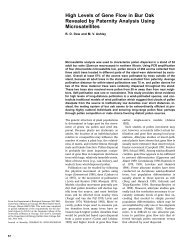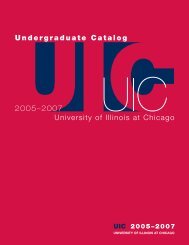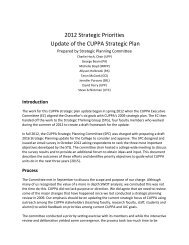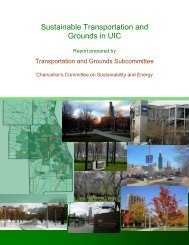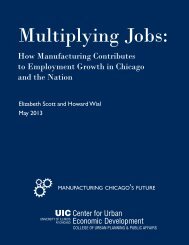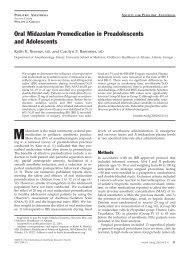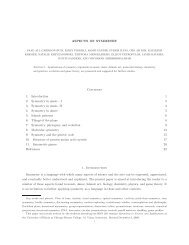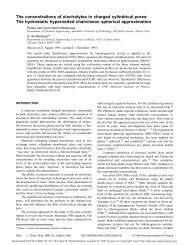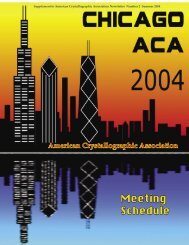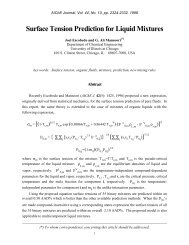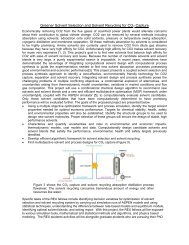Dual-task studies of simulated driving and - Villanova University
Dual-task studies of simulated driving and - Villanova University
Dual-task studies of simulated driving and - Villanova University
Create successful ePaper yourself
Turn your PDF publications into a flip-book with our unique Google optimized e-Paper software.
PSYCHOLOGICAL SCIENCE<br />
Research Article<br />
DRIVEN TO DISTRACTION:<br />
<strong>Dual</strong>-Task Studies <strong>of</strong> Simulated Driving <strong>and</strong> Conversing on a<br />
Cellular Telephone<br />
David L. Strayer <strong>and</strong> William A. Johnston<br />
<strong>University</strong> <strong>of</strong> Utah<br />
Abstract—<strong>Dual</strong>-<strong>task</strong> <strong>studies</strong> assessed the effects <strong>of</strong> cellular-phone<br />
conversations on performance <strong>of</strong> a <strong>simulated</strong> <strong>driving</strong> <strong>task</strong>. Performance<br />
was not disrupted by listening to radio broadcasts or listening<br />
to a book on tape. Nor was it disrupted by a continuous shadowing<br />
<strong>task</strong> using a h<strong>and</strong>held phone, ruling out, in this case, dual-<strong>task</strong> interpretations<br />
associated with holding the phone, listening, or speaking.<br />
However, significant interference was observed in a word-generation<br />
variant <strong>of</strong> the shadowing <strong>task</strong>, <strong>and</strong> this deficit increased with the difficulty<br />
<strong>of</strong> <strong>driving</strong>. Moreover, unconstrained conversations using either a<br />
h<strong>and</strong>held or a h<strong>and</strong>s-free cell phone resulted in a tw<strong>of</strong>old increase in<br />
the failure to detect <strong>simulated</strong> traffic signals <strong>and</strong> slower reactions to<br />
those signals that were detected. We suggest that cellular-phone use<br />
disrupts performance by diverting attention to an engaging cognitive<br />
context other than the one immediately associated with <strong>driving</strong>.<br />
The use <strong>of</strong> cellular telephones has skyrocketed in recent years,<br />
with 116 million subscribers in the United States as <strong>of</strong> June 1, 2001<br />
(Cellular Telecommunications Industry Association, 2001). This increase<br />
in cell-phone users has been accompanied by an increase in the<br />
number <strong>of</strong> individuals concurrently <strong>driving</strong> <strong>and</strong> talking on the cell<br />
phone. For example, recent surveys indicate that 85% <strong>of</strong> cell-phone<br />
owners use their phone at least occasionally while <strong>driving</strong>, <strong>and</strong> 27%<br />
report using their phones on half <strong>of</strong> their trips (Goodman, Bents, et al.,<br />
1999; Goodman, Tijerina, Bents, & Wierwille, 1999). The precise effects<br />
<strong>of</strong> cell-phone use on public safety are unknown; however, driver<br />
inattention <strong>and</strong> other human error have been linked to as much as 50%<br />
<strong>of</strong> the motor-vehicle accidents on U.S. highways (U.S. Department <strong>of</strong><br />
Transportation, 1998). Because <strong>of</strong> the possible increase in risks associated<br />
with the use <strong>of</strong> cell phones while <strong>driving</strong>, several legislative efforts<br />
have been made to restrict cell-phone use on the road. In fact, the<br />
use <strong>of</strong> cellular phones while <strong>driving</strong> is currently restricted in at least<br />
nine countries (Goodman, Bents, et. al., 1999; Goodman, Tijerina, et<br />
al., 1999). In most cases, the legislation regarding cell phones <strong>and</strong><br />
<strong>driving</strong> makes the tacit assumption that the source <strong>of</strong> any interference<br />
from cell-phone use is due to peripheral factors such as dialing <strong>and</strong><br />
holding the phone while conversing. Among other things, this report<br />
evaluates the validity <strong>of</strong> this assumption.<br />
One source <strong>of</strong> evidence concerning the association between cellphone<br />
use <strong>and</strong> motor-vehicle accidents comes from a report by Redelmeier<br />
<strong>and</strong> Tibshirani (1997). In this study, the cellular-phone<br />
records <strong>of</strong> 699 individuals involved in motor-vehicle accidents were<br />
evaluated. It was found that 24% <strong>of</strong> these individuals were using their<br />
cell phone within the 10-min period preceding the accident. The authors<br />
claimed that cell-phone use was associated with a fourfold increase<br />
in the likelihood <strong>of</strong> getting into an accident, <strong>and</strong> that this<br />
increased risk was comparable to that found for <strong>driving</strong> with a blood<br />
alcohol level above the legal limit. In addition, these authors found no<br />
reliable safety advantages for those individuals who used a h<strong>and</strong>s-free<br />
cellular device. The authors concluded that the interference associated<br />
with cell-phone use was due to attentional factors rather than to peripheral<br />
factors such as holding the phone.<br />
The field <strong>studies</strong> <strong>of</strong> Redelmeier <strong>and</strong> Tibshirani (1997) establish a<br />
correlation between cell-phone use <strong>and</strong> motor-vehicle accidents, but<br />
they do not necessarily imply that use <strong>of</strong> cell phones causes an increase<br />
in accident rates. There may be self-selection factors creating an association<br />
between cell-phone use <strong>and</strong> accidents. For example, people<br />
who drive <strong>and</strong> use their cell phone may be more likely to engage in<br />
risky behavior, <strong>and</strong> this increase in risk taking may underlie the correlation.<br />
Similarly, being in a highly emotional state may increase one’s<br />
likelihood <strong>of</strong> <strong>driving</strong> erratically <strong>and</strong> may also increase one’s likelihood<br />
<strong>of</strong> talking on the cell phone. In order to assess the possible causal relationship<br />
between cell-phone use <strong>and</strong> automobile accidents, carefully<br />
controlled experiments, such as the ones described in this report, are<br />
needed.<br />
Prior research has established that the manual manipulation <strong>of</strong><br />
equipment (e.g., dialing the phone, answering the phone, adjusting the<br />
radio) has a negative impact on <strong>driving</strong> (e.g., Briem & Hedman, 1995;<br />
Brookhuis, De Vries, & De Waard, 1991). However, the effects <strong>of</strong> a<br />
phone conversation itself on <strong>driving</strong> are not as well understood, despite<br />
the fact that the duration <strong>of</strong> a typical phone conversation may be up to<br />
two orders <strong>of</strong> magnitude greater than the time required to dial or answer<br />
the phone (Goodman, Bents, et al., 1999; Goodman, Tijerina, et<br />
al., 1999). Briem <strong>and</strong> Hedman (1995) found that simple phone conversations<br />
did not adversely affect the ability to maintain road position.<br />
However, several <strong>studies</strong> using cell phones have found that working<br />
memory <strong>task</strong>s (Alm & Nilsson, 1995; Briem & Hedman, 1995), mental<br />
arithmetic <strong>task</strong>s (McKnight & McKnight, 1993), <strong>and</strong> reasoning <strong>task</strong>s<br />
(Brown, Tickner, & Simmonds, 1969) disrupt <strong>simulated</strong>-<strong>driving</strong> performance.<br />
Although these earlier <strong>studies</strong> provide an important piece <strong>of</strong><br />
the puzzle, the nature <strong>of</strong> many <strong>of</strong> these phone <strong>task</strong>s differs considerably<br />
from the typical cell-phone conversation. 1<br />
In the current research, we focused on the cell-phone conversation,<br />
because it comprises the bulk <strong>of</strong> the time engaged in this dual-<strong>task</strong><br />
pairing. We sought to determine the extent to which cell-phone conversations<br />
might interfere with <strong>driving</strong> <strong>and</strong>, if they do interfere with<br />
<strong>driving</strong>, to determine the precise nature <strong>of</strong> the interference. In particular,<br />
the peripheral-interference hypothesis, tacitly endorsed by the majority<br />
<strong>of</strong> legislative initiatives on the topic, attributes any interference<br />
from cell phones to peripheral factors such as holding the phone while<br />
Address correspondence to David Strayer, Department <strong>of</strong> Psychology, 380<br />
S. 1530 E., Room 502, <strong>University</strong> <strong>of</strong> Utah, Salt Lake City, UT 84112-0251;<br />
e-mail: strayer@psych.utah.edu.<br />
1. Interestingly, Radeborg, Briem, <strong>and</strong> Hedman (1999) provided evidence<br />
that suggests <strong>driving</strong> is also likely to disrupt the cell-phone conversation, implying<br />
that the dual-<strong>task</strong> interference is bi-directional.<br />
462 Copyright © 2001 American Psychological Society VOL. 12, NO. 6, NOVEMBER 2001
PSYCHOLOGICAL SCIENCE<br />
David L. Strayer <strong>and</strong> William A. Johnston<br />
conversing. By contrast, the attentional hypothesis attributes any interference<br />
to the diversion <strong>of</strong> attention from <strong>driving</strong> to the phone conversation<br />
itself.<br />
EXPERIMENT 1<br />
Our first study was designed to contrast the effects <strong>of</strong> h<strong>and</strong>held <strong>and</strong><br />
h<strong>and</strong>s-free cell-phone conversations on a <strong>simulated</strong>-<strong>driving</strong> <strong>task</strong> (viz.,<br />
pursuit tracking). We also included a control group who listened to the<br />
radio while performing the <strong>simulated</strong>-<strong>driving</strong> <strong>task</strong>. As participants<br />
performed the <strong>simulated</strong>-<strong>driving</strong> <strong>task</strong>, occasional red <strong>and</strong> green lights<br />
flashed on the computer display. If participants saw a green light, they<br />
were instructed to continue. However, if a red light was presented,<br />
they were to make a braking response as quickly as possible. The redlight/green-light<br />
manipulation was included to determine how quickly<br />
participants could react to the red light, as well as to determine the<br />
probability <strong>of</strong> failing to detect these <strong>simulated</strong> traffic signals, under<br />
the assumption that slowed reaction time to traffic signals <strong>and</strong> failure<br />
to notice them would contribute significantly to any increase in the<br />
risks associated with <strong>driving</strong> <strong>and</strong> using a cell phone.<br />
Method<br />
Participants<br />
Salt Lake City Olympic Committee bribery sc<strong>and</strong>al (conversations were<br />
counterbalanced across participants). The confederate was seated in a<br />
different room than the participant <strong>and</strong> did not know whether the participant<br />
was using a h<strong>and</strong>held or h<strong>and</strong>s-free phone. The confederate’s<br />
<strong>task</strong> was to facilitate the conversation <strong>and</strong> also to ensure that the participant<br />
listened <strong>and</strong> spoke in approximately equal proportions during<br />
the dual-<strong>task</strong> phase. Throughout the phone conversation, the computer<br />
recorded when the participant was talking <strong>and</strong> when the participant<br />
was listening to the confederate. Participants in the radio control<br />
group listened to a radio broadcast <strong>of</strong> their choosing during the dual<strong>task</strong><br />
portion <strong>of</strong> the experiment.<br />
Results <strong>and</strong> Discussion<br />
Figure 1a presents the probability <strong>of</strong> missing <strong>simulated</strong> traffic signals.<br />
Overall, miss rates were low; however, the probability <strong>of</strong> a miss<br />
more than doubled when participants were engaged in conversations<br />
on the cell phone. In the figure, the data for the two cell-phone groups<br />
(h<strong>and</strong>s-free <strong>and</strong> h<strong>and</strong>held) are collapsed because a preliminary analysis<br />
indicated that there were no reliable differences between these<br />
groups, F(1, 30) 0.06, p .80. A one-way analysis <strong>of</strong> variance<br />
Forty-eight undergraduates (24 male, 24 female) from the <strong>University</strong><br />
<strong>of</strong> Utah participated in the experiment. They ranged in age from<br />
18 to 30, with an average age <strong>of</strong> 21.3. All had normal or corrected-tonormal<br />
vision <strong>and</strong> received a perfect score on the Ishihara color blindness<br />
test (Ishihara, 1993). Participants were r<strong>and</strong>omly assigned to the<br />
three groups: radio control, h<strong>and</strong>held phone, <strong>and</strong> h<strong>and</strong>s-free phone.<br />
Stimuli <strong>and</strong> apparatus<br />
Participants performed a pursuit tracking <strong>task</strong> in which they used a<br />
joystick to maneuver the cursor on a computer display to keep it<br />
aligned as closely as possible to a moving target. The target position<br />
was updated every 33 ms <strong>and</strong> was determined by the sum <strong>of</strong> three sine<br />
waves (0.07 Hz, 0.15 Hz, <strong>and</strong> 0.23 Hz). The target movement was<br />
smooth <strong>and</strong> continuous, yet essentially unpredictable. At intervals<br />
ranging from 10 to 20 s (M 15 s), the target flashed red or green,<br />
<strong>and</strong> participants were instructed to press a “brake button” located in<br />
the thumb position on top <strong>of</strong> the joystick as rapidly as possible when<br />
they detected the red light. Red <strong>and</strong> green lights were equiprobable<br />
<strong>and</strong> were presented in an unpredictable order.<br />
Procedure<br />
The study consisted <strong>of</strong> three phases. The first phase was a warm-up<br />
interval that lasted 7 min <strong>and</strong> was used to acquaint participants with<br />
the tracking <strong>task</strong>. The second phase was the single-<strong>task</strong> portion <strong>of</strong> the<br />
study <strong>and</strong> comprised the 7.5-min segments immediately preceding <strong>and</strong><br />
immediately following the dual-<strong>task</strong> portion <strong>of</strong> the study. During the<br />
single-<strong>task</strong> phase, participants performed the tracking <strong>task</strong> by itself.<br />
The third phase was the dual-<strong>task</strong> portion <strong>of</strong> the study, lasting 15 min.<br />
The dual-<strong>task</strong> condition required the participants to engage in a conversation<br />
with a confederate (or listen to a radio broadcast <strong>of</strong> their<br />
choosing) while concurrently performing the tracking <strong>task</strong>.<br />
Participants in the phone-conversation groups were asked to discuss<br />
either the then-ongoing Clinton presidential impeachment or the<br />
Fig. 1. Probability <strong>of</strong> missing the <strong>simulated</strong> traffic signals (a) <strong>and</strong><br />
mean reaction time to the <strong>simulated</strong> traffic signals (b) in single- <strong>and</strong><br />
dual-<strong>task</strong> conditions in Experiment 1.<br />
VOL. 12, NO. 6, NOVEMBER 2001 463
PSYCHOLOGICAL SCIENCE<br />
Driven to Distraction<br />
(ANOVA) indicated that the probability <strong>of</strong> missing red lights increased<br />
from single- to dual-<strong>task</strong> conditions for the combined cellphone<br />
group, F(1, 30) 8.8, p .01. By contrast, the difference between<br />
single- <strong>and</strong> dual-<strong>task</strong> conditions was not reliable for the radio<br />
control group, F(1, 15) 0.64, p .44.<br />
The reaction time to the <strong>simulated</strong> traffic signals is presented in<br />
Figure 1b. As with the miss data, the data for the two cell-phone<br />
groups (h<strong>and</strong>held <strong>and</strong> h<strong>and</strong>s-free) were collapsed because preliminary<br />
analyses indicated that there were no reliable differences between<br />
these groups, F(1, 30) 0.01, p .90. A one-way ANOVA revealed<br />
that participants in the combined cell-phone group responded more<br />
slowly in the dual-<strong>task</strong> condition than in the single-<strong>task</strong> condition,<br />
F(1, 30) 28.9, p .01. A subsidiary analysis <strong>of</strong> this combined<br />
group found that the disruptive effects <strong>of</strong> the phone conversation were<br />
greater when participants were talking than when they were listening<br />
to the confederate, although both dual-<strong>task</strong> deficits were reliable,<br />
F(2, 60) 19.8, p .01. 2 There again was no indication <strong>of</strong> a dual<strong>task</strong><br />
decrement for the radio control group. Indeed, there was a tendency<br />
for reaction time to decrease in the dual-<strong>task</strong> condition for this<br />
group, F(1, 15) 3.2, p .09.<br />
These data are important because they demonstrate that the phone<br />
conversation itself resulted in significant slowing in response to <strong>simulated</strong><br />
traffic signals, as well as an increase in the probability <strong>of</strong> missing<br />
these signals. Moreover, the fact that h<strong>and</strong>held <strong>and</strong> h<strong>and</strong>s-free cell<br />
phones resulted in equivalent dual-<strong>task</strong> deficits indicates that the interference<br />
was not due to peripheral factors such as holding the phone<br />
while conversing. These data are also consistent with the <strong>studies</strong> reporting<br />
no reliable performance differences between participants using<br />
h<strong>and</strong>held <strong>and</strong> h<strong>and</strong>s-free cell phones (Redelmeier & Tibshirani,<br />
1997).<br />
Additional Control Condition<br />
There were no dual-<strong>task</strong> decrements associated with listening to<br />
radio broadcasts in Experiment 1. Although this control condition<br />
mimicked real-world situations, the broadcasts involved a mixture <strong>of</strong><br />
music <strong>and</strong> speech, <strong>and</strong> we did not assess how well participants attended<br />
to this material. Therefore, we ran an additional control condition<br />
in which participants listened to a selected passage from a book<br />
on tape during the dual-<strong>task</strong> portion <strong>of</strong> the study. Participants were informed<br />
that at the completion <strong>of</strong> the study they would be asked a series<br />
<strong>of</strong> questions about the book on tape. Only participants who<br />
received scores <strong>of</strong> at least 90% on this posttest were included in the<br />
subsequent analyses. Thus, the book-on-tape control condition was<br />
specifically designed to ensure that participants attended to the verbal<br />
material in the dual-<strong>task</strong> portion <strong>of</strong> the study.<br />
Method<br />
Twenty undergraduates (10 male <strong>and</strong> 10 female) from the <strong>University</strong><br />
<strong>of</strong> Utah participated. They ranged in age from 18 to 30, with a<br />
mean age <strong>of</strong> 20.8. All had normal or corrected-to-normal vision <strong>and</strong><br />
received a perfect score on the Ishihara color blindness test (Ishihara,<br />
1993).<br />
2. Miss rates were also greater when participants were speaking than when<br />
they were listening; however, this trend was not reliable.<br />
The procedure was identical to that used for the radio control condition,<br />
with the exception that participants listened to selected portions<br />
from a book on tape (Brokaw, 1998) during the dual-<strong>task</strong> phase <strong>of</strong> the<br />
experiment. At the end <strong>of</strong> the study, participants completed a 10-item<br />
multiple-choice questionnaire to assess the degree to which they had<br />
attended to the verbal material from the book on tape. Four participants<br />
who failed to score at least 90% on the posttest were omitted<br />
from subsequent analyses, resulting in a sample <strong>of</strong> 16 participants who<br />
clearly attended to the book on tape.<br />
Results <strong>and</strong> discussion<br />
Results were similar to those for the radio control condition: There<br />
was no difference between the single- <strong>and</strong> dual-<strong>task</strong> conditions either<br />
in the rate <strong>of</strong> missing <strong>simulated</strong> traffic signals (.017 vs. .026, respectively),<br />
F(1, 15) 0.77, p .39, or in the reaction time to these signals<br />
(541 ms vs. 537 ms, respectively), F(1, 15) 0.12, p .73.<br />
Thus, listening to a book on tape did not result in significant impairment<br />
on the <strong>simulated</strong>-<strong>driving</strong> <strong>task</strong>. These findings are important because<br />
they rule out interpretations that attribute the dual-<strong>task</strong> deficits<br />
associated with a cell-phone conversation to simply attending to verbal<br />
material. Active engagement in the cell-phone conversation appears<br />
to be necessary to produce the dual-<strong>task</strong> interference observed in<br />
Experiment 1.<br />
Subsidiary analyses were also performed on the dual-<strong>task</strong>/single<strong>task</strong><br />
difference scores for the cell-phone <strong>and</strong> control groups. In these<br />
analyses, the radio <strong>and</strong> book-on-tape control groups were combined,<br />
because preliminary analyses revealed that these groups did not differ<br />
significantly from each other (all ps .30). Indeed, the planned comparisons<br />
reported earlier indicated that neither control group exhibited<br />
reliable dual-<strong>task</strong> decrements. The aggregated data were analyzed using<br />
a 2 (group: cell phone vs. control) 2 (<strong>task</strong>: single vs. dual) splitplot<br />
ANOVA. Analysis <strong>of</strong> the difference scores revealed that the increase<br />
in miss rates from single- to dual-<strong>task</strong> conditions was greater<br />
for the cell-phone group than for the control group, F(1, 62) 4.97,<br />
p .05, <strong>and</strong> that the increase in reaction time from single- to dual<strong>task</strong><br />
conditions was greater for the cell-phone group than for the control<br />
group, F(1, 62) 29.9, p .01. Finally, an analysis <strong>of</strong> covariance<br />
indicated that neither gender nor age contributed to the group differences<br />
reported in this experiment (all ps .30).<br />
EXPERIMENT 2<br />
In our second study, we attempted to more specifically localize the<br />
source <strong>of</strong> cell-phone interference on <strong>driving</strong>. Participants performed<br />
the <strong>simulated</strong>-<strong>driving</strong> <strong>task</strong> on both an easy, predictable course <strong>and</strong> a<br />
difficult, unpredictable course. After a warm-up phase acquainting<br />
participants with the simulator, they performed each course in single<strong>task</strong><br />
mode as well as in two dual-<strong>task</strong> conditions involving the use <strong>of</strong> a<br />
cell phone. One <strong>of</strong> the dual-<strong>task</strong> conditions was a shadowing <strong>task</strong> in<br />
which the participants performed the <strong>simulated</strong>-<strong>driving</strong> <strong>task</strong> while<br />
they repeated words that the experimenter read to them over a h<strong>and</strong>held<br />
cell phone. Thus, the shadowing dual-<strong>task</strong> condition assessed the<br />
contribution <strong>of</strong> holding the phone, listening, <strong>and</strong> speaking to the dual<strong>task</strong><br />
performance deficits. The other dual-<strong>task</strong> condition was a wordgeneration<br />
<strong>task</strong> that was identical to the shadowing <strong>task</strong> with the exception<br />
that the participant was required to generate a new word that<br />
began with the last letter <strong>of</strong> the word read by the experimenter. For example,<br />
if the experimenter read the word “molar,” the participant was<br />
464 VOL. 12, NO. 6, NOVEMBER 2001
PSYCHOLOGICAL SCIENCE<br />
David L. Strayer <strong>and</strong> William A. Johnston<br />
required to generate a word that began with the letter r (e.g., “robot”).<br />
Note that the only difference between the two dual-<strong>task</strong> conditions<br />
was the attentional dem<strong>and</strong>s imposed by the word-generation process.<br />
In this study, we measured the deviations from the ideal tracking position<br />
under the assumption that deviations in tracking would contribute<br />
significantly to any increase in the risks associated with <strong>driving</strong> while<br />
using a cell phone.<br />
Method<br />
Participants<br />
Twenty-four undergraduates (12 male <strong>and</strong> 12 female) from the<br />
<strong>University</strong> <strong>of</strong> Utah participated in the experiment. They ranged in age<br />
from 18 to 26, with an average age <strong>of</strong> 20.5. All had normal or corrected-to-normal<br />
vision <strong>and</strong> received a perfect score on the Ishihara<br />
color blindness test (Ishihara, 1993).<br />
Stimuli <strong>and</strong> apparatus<br />
In the easy course, the position <strong>of</strong> the target was determined by a<br />
0.035-Hz sine wave. In the difficult course, the target position was determined<br />
using the same algorithm as in Experiment 1; however, the<br />
red-light/green-light manipulation from the first study was not included<br />
in this variant <strong>of</strong> the tracking <strong>task</strong>, because we found that responding<br />
to the <strong>simulated</strong> traffic signals added substantial noise to the<br />
tracking data.<br />
Procedure<br />
Participants performed a pursuit tracking <strong>task</strong> similar to that used<br />
in the first study. The easy <strong>and</strong> difficult conditions were blocked in<br />
counterbalanced order, <strong>and</strong> the order <strong>of</strong> single- <strong>and</strong> dual-<strong>task</strong> conditions<br />
was counterbalanced within each level <strong>of</strong> course difficulty. In<br />
both dual-<strong>task</strong> conditions, the experimenter read four- <strong>and</strong> five-letter<br />
words to the participant at a rate <strong>of</strong> one word every 3 s. The word lists<br />
used in the experiment were counterbalanced across participants <strong>and</strong><br />
conditions.<br />
Results <strong>and</strong> Discussion<br />
Figure 2 presents the root mean squared (RMS) tracking error as a<br />
function <strong>of</strong> experimental condition. The data were analyzed using a 2<br />
(tracking difficulty: easy vs. difficult) 3 (<strong>task</strong>: single, shadowing,<br />
<strong>and</strong> word generation) repeated measures ANOVA. The analysis revealed<br />
that RMS error increased as a function <strong>of</strong> tracking difficulty,<br />
F(1, 23) 49.8, p .01, <strong>and</strong> <strong>task</strong>, F(2, 46) 13.4, p .01, <strong>and</strong> that<br />
these two effects interacted, F(2, 46) 7.7, p .01. A series <strong>of</strong><br />
planned comparisons clarified the nature <strong>of</strong> this interaction. Single<strong>task</strong><br />
tracking error increased from the easy to the difficult condition,<br />
F(1, 23) 48.8, p .01. The shadowing dual-<strong>task</strong> condition did not<br />
reliably differ from the single-<strong>task</strong> control condition, F(1, 23) 3.7,<br />
p .07. However, the word-generation <strong>task</strong> produced significant increases<br />
in tracking error, F(1, 23) 17.6, p .01, <strong>and</strong> this effect was<br />
especially pronounced in the difficult <strong>driving</strong> condition, F(1, 23) <br />
10.0, p .01. The fact that the shadowing <strong>task</strong> did not reliably elevate<br />
tracking error further discredits interpretations that attribute dual-<strong>task</strong><br />
cell-phone deficits to peripheral factors such as holding the phone<br />
while conversing. In addition, these data indicate that the peripheral<br />
processes <strong>of</strong> speaking <strong>and</strong> listening do not appear to be major sources<br />
Fig. 2. Root mean squared (RMS) tracking error for the easy <strong>and</strong> difficult<br />
courses in single- <strong>and</strong> dual-<strong>task</strong> conditions in Experiment 2.<br />
<strong>of</strong> interference. However, it is important to caution that our <strong>studies</strong> do<br />
not rule out all peripheral sources <strong>of</strong> interference. Indeed, there was a<br />
trend toward interference in the shadowing <strong>task</strong> that may have important<br />
implications in the real world (cf. L<strong>of</strong>tus, 1996). Moreover, there<br />
is clear evidence that manipulation <strong>of</strong> a phone while dialing is associated<br />
with significant dual-<strong>task</strong> interference (e.g., Briem & Hedman,<br />
1995; Brookhuis et al., 1991).<br />
GENERAL DISCUSSION<br />
The principal findings are that (a) when participants were engaged<br />
in cell-phone conversations, they missed twice as many <strong>simulated</strong> traffic<br />
signals as when they were not talking on the cell phone <strong>and</strong> took<br />
longer to react to those signals that they did detect; (b) these deficits<br />
were equivalent for h<strong>and</strong>held <strong>and</strong> h<strong>and</strong>s-free cell-phone users; <strong>and</strong> (c)<br />
tracking error increased when participants used the cell phone to perform<br />
an active, attention-dem<strong>and</strong>ing word-generation <strong>task</strong> but not<br />
when they performed a shadowing <strong>task</strong>.<br />
These data are consistent with an attention-based interpretation in<br />
which the disruptive effects <strong>of</strong> cell-phone conversations on <strong>driving</strong> are<br />
due primarily to the diversion <strong>of</strong> attention from <strong>driving</strong> to the phone<br />
conversation itself. The largest dual-<strong>task</strong> performance deficits were<br />
obtained in the generative portions <strong>of</strong> the cell-phone conversations;<br />
however, even the listening components were associated with dual<strong>task</strong><br />
decrements. Thus, the simulator <strong>studies</strong> described in this report<br />
<strong>and</strong> the field <strong>studies</strong> <strong>of</strong> Redelmeier <strong>and</strong> Tibshirani (1997) provide converging<br />
evidence on the locus <strong>of</strong> interference. We note that these results<br />
are problematic for multiple-resource models <strong>of</strong> divided attention<br />
(e.g., Wickens, 1992). Such models suggest that an auditory-verbalvocal<br />
cell-phone conversation should not interfere substantially with a<br />
visual-spatial-manual <strong>driving</strong> <strong>task</strong> (see also Briem & Hedman, 1995;<br />
Moray, 1999). Indeed, attending to auditory inputs in the radio <strong>and</strong><br />
book-on-tape control conditions <strong>of</strong> Experiment 1 <strong>and</strong> in the shadowing<br />
<strong>task</strong> <strong>of</strong> Experiment 2 did not lead to dual-<strong>task</strong> interference; however,<br />
conversing using either a h<strong>and</strong>held or a h<strong>and</strong>s-free cell phone in<br />
Experiment 1 <strong>and</strong> word generation in Experiment 2 resulted in significant<br />
interference. Wickens (1999) has suggested that multiple-resource<br />
VOL. 12, NO. 6, NOVEMBER 2001 465
PSYCHOLOGICAL SCIENCE<br />
Driven to Distraction<br />
models might be able to account for the interference between cellphone<br />
conversations <strong>and</strong> <strong>driving</strong> because there may be an overlap in<br />
the stages <strong>of</strong> processing between the two <strong>task</strong>s. But given the similarity<br />
<strong>of</strong> the stages <strong>of</strong> processing in the shadowing <strong>and</strong> generation conditions<br />
<strong>of</strong> Experiment 2, this interpretation would seem to erroneously<br />
predict similar patterns <strong>of</strong> dual-<strong>task</strong> interference for these two conditions.<br />
3<br />
We suggest that cellular-phone use disrupts performance by diverting<br />
attention to an engaging cognitive context other than the one immediately<br />
associated with <strong>driving</strong>. Some aspects <strong>of</strong> <strong>driving</strong> are<br />
inherently unpredictable (e.g., reacting to a child who darts across the<br />
street), <strong>and</strong> when attention is diverted from the <strong>driving</strong> context, the appropriate<br />
reactions to these unpredictable events will be impaired.<br />
Thus, the dual-<strong>task</strong> decrements described in this article appear to be<br />
consistent with the literatures on <strong>task</strong> <strong>and</strong> attention switching (e.g.,<br />
Allport, Styles, & Hsieh, 1994; Gopher, Greenshpan, & Armony,<br />
1996; Rogers & Monsell, 1995).<br />
It is also interesting to consider the potential differences between<br />
cell-phone conversations <strong>and</strong> in-person conversations with other occupants<br />
<strong>of</strong> the vehicle. Although there need not be differences between<br />
these two modes <strong>of</strong> communication, there is evidence that in-person<br />
conversations are modulated by <strong>driving</strong> difficulty, so that as the dem<strong>and</strong>s<br />
<strong>of</strong> <strong>driving</strong> increase, participation by all participants in a conversation<br />
decreases (Parks, 1991). By contrast, at least one <strong>of</strong> the<br />
participants in a cellular-phone conversation is unaware <strong>of</strong> the current<br />
<strong>driving</strong> conditions (<strong>and</strong> may even be unaware that the cell-phone user<br />
is <strong>driving</strong>). Under such circumstances, it is less likely that the conversation<br />
will be modulated as a function <strong>of</strong> the real-time variations in <strong>driving</strong><br />
difficulty. Moreover, although other in-car dual-<strong>task</strong> activities (e.g.,<br />
dialing the phone, eating a s<strong>and</strong>wich) are under the direct control <strong>of</strong> the<br />
driver, when the driver engages in a cell-phone conversation, he or she<br />
is no longer solely in control <strong>of</strong> the dynamics <strong>of</strong> the conversation (i.e., a<br />
cell-phone conversation is jointly controlled by the participants).<br />
In sum, we found that conversing on either a h<strong>and</strong>held or a h<strong>and</strong>sfree<br />
cell phone led to significant decrements in <strong>simulated</strong>-<strong>driving</strong> performance.<br />
Thus, the available evidence indicates that there are at least<br />
two sources <strong>of</strong> interference with <strong>driving</strong> associated with concurrent<br />
cell-phone use: one due to peripheral factors such as manipulating the<br />
3. Because performance was not measured in single-<strong>task</strong> shadowing <strong>and</strong><br />
generation conditions, it is possible that the differences in dual-<strong>task</strong> interference<br />
are due to differences in the difficulty <strong>of</strong> the two <strong>task</strong>s. Even so, the differences<br />
in difficulty would be associated with attention-dem<strong>and</strong>ing generative<br />
components <strong>of</strong> processing, rather than with peripheral processes associated<br />
with holding the phone, listening, <strong>and</strong> speaking.<br />
phone while dialing (e.g., Briem & Hedman, 1995; Brookhuis et al.,<br />
1991) <strong>and</strong> one due to the phone conversation itself. Our data imply<br />
that legislative initiatives that restrict h<strong>and</strong>held devices but permit<br />
h<strong>and</strong>s-free devices are not likely to reduce interference from the phone<br />
conversation, because the interference is, in this case, due to central attentional<br />
processes.<br />
REFERENCES<br />
Allport, A., Styles, E.A., & Hsieh, S. (1994). Shifting intentional set: Exploring the dynamic<br />
control <strong>of</strong> <strong>task</strong>s. In C. Umilta & M. Moscovitch (Eds.), Attention <strong>and</strong> performance<br />
IV (pp. 421–452). Cambridge, MA: MIT Press.<br />
Alm, H., & Nilsson, L. (1995). The effects <strong>of</strong> a mobile telephone <strong>task</strong> on driver behaviour<br />
in a car following situation. Accident Analysis <strong>and</strong> Prevention, 27, 707–715.<br />
Briem, V., & Hedman, L.R. (1995). Behavioural effects <strong>of</strong> mobile telephone use during<br />
<strong>simulated</strong> <strong>driving</strong>. Ergonomics, 38, 2536–2562.<br />
Brokaw, T. (1998). The greatest generation (sound recording: abridged) [Cassette]. New<br />
York: R<strong>and</strong>om House Audio Books.<br />
Brookhuis, K.A., De Vries, G., & De Waard, D. (1991). The effects <strong>of</strong> mobile telephoning<br />
on <strong>driving</strong> performance. Accident Analysis <strong>and</strong> Prevention, 23, 309–316.<br />
Brown, I.D., Tickner, A.H., & Simmonds, D.C.V. (1969). Interference between concurrent<br />
<strong>task</strong>s <strong>of</strong> <strong>driving</strong> <strong>and</strong> telephoning. Journal <strong>of</strong> Applied Psychology, 53, 419–424.<br />
Cellular Telecommunications Industry Association. (2001). CTIA’s world <strong>of</strong> wireless communications<br />
[On-line]. Available: http://www.wow-com.com/<br />
Goodman, M.J., Bents, F.D., Tijerina, L., Wierwille, W., Lerner, N., & Benel, D. (1999).<br />
An investigation <strong>of</strong> the safety implications <strong>of</strong> wireless communication in vehicles:<br />
Report summary [On-line]. Available: http://www.nhtsa.dot.gov/people/injury/<br />
research/wireless/#rep<br />
Goodman, M.J., Tijerina, L., Bents, F.D., & Wierwille, W.W. (1999). Using cellular telephones<br />
in vehicles: Safe or unsafe? Transportation Human Factors, 1, 3–42.<br />
Gopher, D., Greenshpan, Y., & Armony, L. (1996). Switching attention between <strong>task</strong>s: Exploration<br />
<strong>of</strong> the components <strong>of</strong> executive control <strong>and</strong> their development with training.<br />
In Proceedings <strong>of</strong> the Human Factors <strong>and</strong> Ergonomics Society 40th annual<br />
meeting (pp. 1060–1064). Philadelphia: Human Factors <strong>and</strong> Ergonomics Society.<br />
Ishihara, S. (1993). Ishihara’s tests for colour-blindness. Tokyo, Japan: Kanehara & Co.<br />
L<strong>of</strong>tus, G.R. (1996). Psychology will be a much better science when we change the way<br />
we analyze data. Current Directions in Psychological Science, 5, 161–171.<br />
McKnight, A., & McKnight, A. (1993). The effect <strong>of</strong> cellular phone use upon driver attention.<br />
Accident Analysis <strong>and</strong> Prevention, 25, 259–265.<br />
Moray, N. (1999). Commentary on Goodman, Tijerina, Bents, <strong>and</strong> Wierwille, “Using Cellular<br />
Telephones in Vehicles: Safe or Unsafe?” Transportation Human Factors, 1,<br />
43–46.<br />
Parks, A.M. (1991). Drivers business decision making ability whilst using carphones. In E.<br />
Lovessey (Ed.), Contemporary ergonomics: Proceedings <strong>of</strong> the Ergonomic Society<br />
annual conference (pp. 427–432). London: Taylor & Francis.<br />
Radeborg, K., Briem, V., & Hedman, L.R. (1999). The effect <strong>of</strong> concurrent <strong>task</strong> difficulty<br />
on working memory during <strong>simulated</strong> <strong>driving</strong>. Ergonomics, 42, 767–777.<br />
Redelmeier, D.A., & Tibshirani, R.J. (1997). Association between cellular-telephone calls<br />
<strong>and</strong> motor vehicle collisions. The New Engl<strong>and</strong> Journal <strong>of</strong> Medicine, 336, 453–458.<br />
Rogers, R.D., & Monsell, S. (1995). Costs <strong>of</strong> a predictable switch between simple cognitive<br />
<strong>task</strong>s. Journal <strong>of</strong> Experimental Psychology: General, 124, 207–231.<br />
U.S. Department <strong>of</strong> Transportation. (1998). Transportation Statistics Annual Report,<br />
1998: Long-distance travel <strong>and</strong> freight, chapter 3 [On-line]. Available: http://<br />
www.bts.gov/programs/transtu/tsar/tsar98/chap3.pdf<br />
Wickens, C.D. (1992). Engineering psychology <strong>and</strong> human performance. New York: HarperCollins.<br />
Wickens, C.D. (1999). [Letter to the editor]. Transportation Human Factors, 1, 205–206.<br />
(RECEIVED 5/29/00; REVISION ACCEPTED 1/23/01)<br />
466 VOL. 12, NO. 6, NOVEMBER 2001



